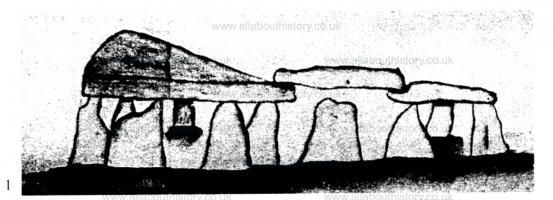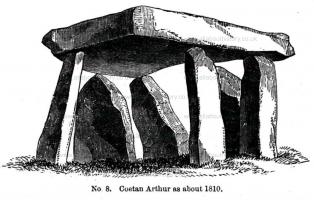Text this colour links to Pages. Text this colour links to Family Trees. Text this colour are links that are disabled for Guests.
Place the mouse over images to see a larger image. Click on paintings to see the painter's Biography Page. Mouse over links for a preview. Move the mouse off the painting or link to close the popup.
Ystum Cegid aka Coetan Arthur Burial Mound is in Criccieth, Prehistoric Wales Neolithic Burials.

Archaeologia Cambrensis 1999 Pages 207-213. Farrington in his Snowdonia Druidica of 1769 provides a description [of Ystum Cegid aka Coetan Arthur Burial Mound [Map]] and a very clear diagram which shows the large thin capstone supported by six uprights, with cairn material on top of it, with two other overlapping capstones to the north; the first with one stone and the other with three stones visible beneath it. There is a hint that stones may have filled the chamber and the front of the passage. This drawing of a continuous tripartite structure is the crucial image and it is consistent with the present remains, despite subsequent interference (Fig. 1.1).
Archaeologia Cambrensis 1849 Page 1. Cefn Ystym Cegid [Map] & Dolbenmaen Monumts-—Cefn is a farm on the right hand of the road leading from Clynnog to Dolbenmaen; to the west of the house a most stately beautiful cromlech, neither alter'd by time nor injured by any accidental violence. Its superficies gibbous, underneath flat, having 5 strong supporters; it is call'd the Goetan, &c. Ystym Cegid stands opposite to this, on the other side of the river Cegid; and in a stone wall that runs from the house to the rock above it, stand 3 uncommon columns, whose tops resemble javelin points; one is 2 cubits in length & 1 in breadth; the other, 2 cubits & -J high & 3 broad; the third, 3 cubits in length and 2J in breadth, &c. Not far from these, on a rising ground called Bryn y gogo, i. e. The Hill of Prayer, stands the grand triple cromlech called Coetan Arthur. The largest table stone is triangular, & in length 8 cubits, in breadth 5, supported by six pillars. The 2d, which rest upon it an un trapezium, in length 5 cubits, breadth 2, stands upon three pillars. The 3d roofstone, a flat quadrilateral shiver, 3 cubits long and 2^ broad, stands upon 4 pillars. The ends of the middle covering stone rest Mrs. Eobert Williams, the lady of the present vicar of Clynnog Fawr. The following are the dimensions of the cromlech with which Mrs. Williams has favoured us: Total height of eastern end 5ft. 5in.; do. supporting stone 3ft. 6in.; thickness of cromlech at eastern end 1ft. llin.; total height of western end 4ft. 3in.; do. Oi upporting stone 3ft. 9in.; thickness of western end of cromlech 6in.; whole length of upper stone 8ft. 6in. upon the other two. In the way to it appears a directing stone. In the field adjoyning it, a tall pillar, another lying on the ground very near it. A little distance to the west, the low arch'd stone, &ec., farther on in the bottom, several carnedds remov'd, and an oval 12 paces one way & 17 the other. The inclination of the triple cromlech is to the north. In the way to Dolbenmaen, in a hedge row, stands a lonely pillar, in height 4 cubits, in breadth 2. To the left of the road, in a field calld Rhyd y Cawg, are 2 pillars, sloping different ways; in another field, to the east, the remains of a Druid cirque. In the Parson's garden a pillar, 4 cubits long old. Between the church and Dolwgan stands the famous Maen Arthur, or rather Maen Sigl, being a vast round orb, now off its axis; it faces the accomplish'd Oval of Cwm Mawr. The author supposes Dolbenmaen to derive its name from this stone. Ystym Cegid, anciently calld Cefn y Fan; tradition says that John ap Meredydd's house stood in a field call'd Cae y Mur Poeth.
![]() Become a Member via our Buy Me a Coffee page to read complete text.
Become a Member via our Buy Me a Coffee page to read complete text.

Archaeologia Volume 34 1851 Section 8. Account of Ystumcegid Cromlech [Map], in the parish of Llanfihangel-y-Pennant, county of Carnarvon. By NATHANIEL NEAL SOLLY, Esq. Communicated in a Letter to Captain W. H. Smyth, R.N., K.S.F., Director. Read December 5, 1850.

Archaeologia Cambrensis 1869 Page 118-147 Cromlechs in North Wales. (Cut 8.) From this it will be seen that it was tolerably perfect when he saw it, except that, unless the intervals between the uprights had been originally filled up with rubble, some of the uprights must have been wanting. It was, however, at that time used as a cow-house by the farmer, and the vacant spaces were then filled up with walling, but most probably by the farmer himself. The present remains, exclusive of the capstone, are three upright supporters, one lying under the cover,and another in the ditch. The tallest of the upright ones is 5 ft. 6 ins., and the prostrate one, 6 ft. 9 ins. The chamber originally was about 10 ft. by 9. A considerable number of small stones are amassed around it; but whether merely collected there to be out of the way, or the remains of the original carn, is uncertain. In the present mutilated state it is not easy to determine what the direction of the chamber was. The entrance, however, could not have been on the south or west side; and although it may have been on the north side, it appears to have been on the usual side, namely the east. It is only known by the peasants as Coetan Arthur [Map]; and if questioned, they appear to have never heard of a cromlech or a Druid's altar. Nor is this ignorance confined to this particular district, for it appears to exist in most other parts of Wales.

Archaeologia Cambrensis 1869 Page 118-147 Cromlechs in North Wales. Not far from Criccieth, near Ystym Cegid [Ystum Cegid aka Coetan Arthur Burial Mound [Map]], are the last remains of what must have been, in Pennant's time, an interesting group of three cromlechs "joining to each other." If by these words he meant that they actually touched each other, the tumulus that enclosed them must have been of gigantic proportions. Gigantic as it was, it had so completely disappeared in Pennant's time that he does not even appear to have suspected its existence. He merely speaks of the three structures as probably "memorials of three chieftains slain on the spot." Of these cromlechs, however, two have entirely vanished; and the remains of the third are small and insignificant, consisting of what have been four supporters of very moderate dimensions, and the capstone, of a triangular form (cut No. 7); its greatest length being between fourteen and fifteen feet, and its greatest breadth twelve and a half. Its thickness, however, has not the usual proportion, being unusually thin and slight, It is only very lately that this covering slab was dislodged from its original position by some masons who had taken a fancy to one of the supporters for some building purpose; and it is very probable, unless proper precaution is taken, that what still remains of this triple group will vanish, and not leave even a trace of itself. The removal, however, of two of the three must have taken place some fifty years ago, and not long after Pennant's visit, for Pugh, in his Cambria Depicta, in the early part of the present century, drew the monument as he found it, and as is here given from his drawing.
Archaeologia Cambrensis 1999 Pages 207-213. A fresh look at Ystum Cegid Isaf Megalithic Tomb [Map] (Caern.) By Frances Lynch.
The monument at Ystum Cegid Isaf in Llanystumdwy parish (SH 499 413) situated in the broken, rocky, marshy country north of Criccieth has not received a great deal of attention in recent megalithic studies. It has been much disturbed and is one of several sites which have been re-erected—always a source of uncertainty in analysis; moreover, if it is a Passage Grave, it is an awkward outlier, unrelated to its nearest neighbours. Consequently few people have been keen to discuss it at length. On its last appearance in Archaeologia Cambrensis it was described in rather condescending terms as ‘not a specimen of the first importance, although of considerable size' (Anon, 1904, 148).
This twentieth-century neglect contrasts with the situation in the late eighteenth and nineteenth centuries when the monument was described and drawn several times (Farrington, 1769; Rhyl MS 1772; Pennant, 1783; Colt Hoare Views in Wales NLW edition; Pugh, 1816; Barwell, 1869; Owen, 1903 (quoting Williams, 1871)).
The first commentators were impressed by the monument in its much more complete form, although when first described most of the cairn must have alreacy been removed and the surviving chamber perhaps incorporated into a stone wall.